博文
Fluorescent Probe forRatiometric Monitoring of Peroxynitrite
|
Zhenkai Wang【王振凯】 a,b,c,†, Miao Yan,a,† Miaomiao Yua, Gang Zhanga, Weiwei Fang【房微魏】*,a, Fabiao Yu【于法标】*,b,c,
a Jiangsu Co-Innovation Center of Efficient Processing and Utilization of Forest Resources, International Innovation Center for Forest Chemicals and Materials, College of Chemical Engineering, Nanjing Forestry University, 159 Longpan Road, 210037, Nanjing, China.
b Key Laboratory of Hainan Trauma and Disaster Rescue, Key Laboratory of Haikou Trauma, The First Affiliated Hospital of Hainan Medical University, Hainan Medical University, Haikou 571199, China.
c Engineering Research Center for Hainan Bio-Smart Materials and Bio-Medical Devices, Key Laboratory of Emergency and Trauma, Ministry of Education, Key Laboratory of Hainan Functional Materials and Molecular Imaging, College of Emergency and Trauma, Hainan Medical University, Haikou 571199, China
†These authors contributed equally to this work
Cite this: Anal. Chem. 2024, 96, 8, 3600–3608Publication Date:February 19, 2024
https://doi.org/10.1021/acs.analchem.3c05718
Copyright © 2024 American Chemical Society
SUBJECTS:Fluorescence,Fluorescence imaging,Mixtures,Probes, Rodent models
AbstractPeroxynitrite (ONOO–), as a short-term reactive biological oxidant, could lead to a series of effects in various physiological and pathological processes due to its subtle concentration changes. In vivo monitoring of ONOO– and relevant physiological processes is urgently required. Herein, we describe a novel fluorescent probe termed HBT-Fl-BnB for the ratiometric detection of ONOO– in vitro and in vivo. The probe consists of an HBT core with Fl groups at the ortho and para positions responding to the zwitterionic excited-state intramolecular proton-transfer (zwitterionic ESIPT) process and a boronic acid pinacol ester with dual roles that block the zwitterionic ESIPT and recognize ONOO–. Thanks to the specificity as well as low cytotoxicity, success in imaging of endogenous and exogenous ONOO– in living cells by HBT-Fl-BnB was obtained. Additionally, the applicability of HBT-Fl-BnB to tracking the abnormal expression of ONOO– in vivo induced by inactivated Escherichia coli was also explored. This is the first report of a fluorescent probe for ONOO– sensing via a zwitterionic ESIPT mechanism.

摘要



过氧亚硝酸盐(ONOO−)作为一种短期反应性生物氧化剂,由于其浓度的微妙变化,可对多种生理和病理过程产生一系列影响。迫切需要对 ONOO− 和相关生理过程进行体内监测。
在此,作者描述了一种称为 HBT-Fl-BnB 的新型荧光探针,用于体外和体内 ONOO− 的比例检测。该探针由一个在邻位和对位具有 Fl 基团的 HBT 核心组成,该核心响应两性离子激发态分子内质子转移(两性离子 ESIPT)过程,以及具有双重作用的硼酸频哪醇酯,可阻断两性离子 ESIPT 并识别 ONOO− 。由于其特异性和低细胞毒性,HBT-Fl-BnB 成功对活细胞中的内源性和外源性 ONOO− 进行成像。此外,还探讨了 HBT-Fl-BnB 在追踪灭活大肠杆菌诱导的体内 ONOO− 异常表达方面的适用性。这是通过两性离子 ESIPT 机制进行 ONOO− 传感的荧光探针的第一份报告。
图文解析



方案1.设计HBT-Fl-BnB及其相关合成路线。
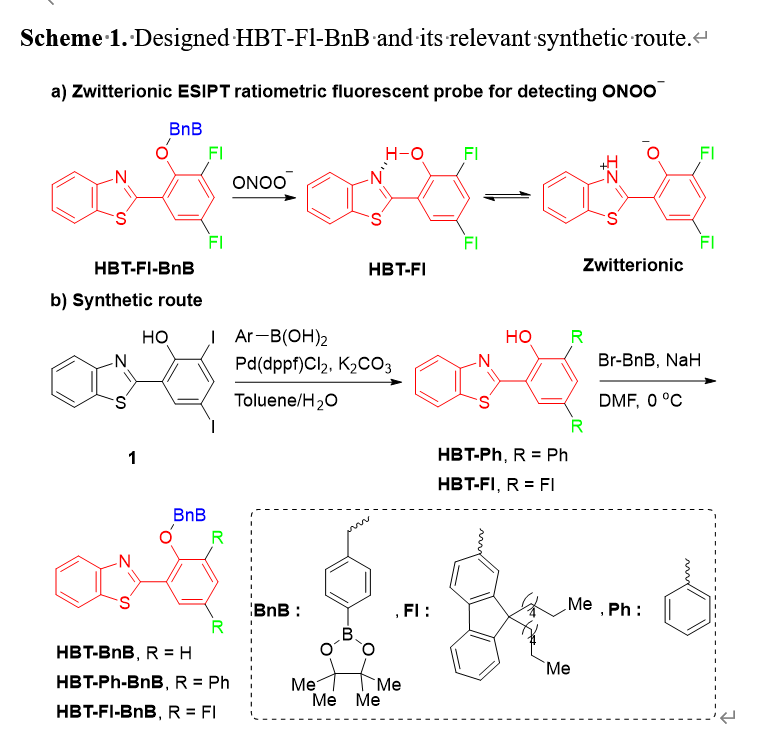
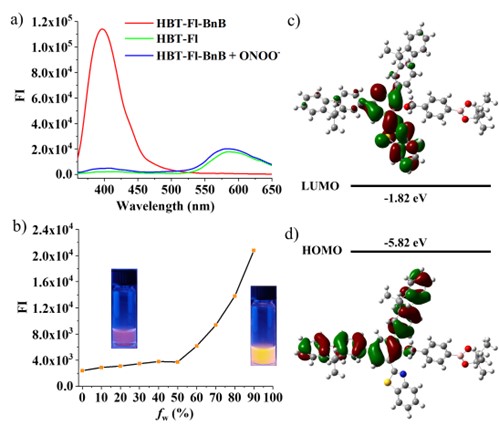
图 1. (a) 含有过量 ONOO− 的 HBT-Fl-BnB、HBT-Fl 和 HBT-Fl-BnB 的荧光光谱(10 μM 和 10 mM PBS 缓冲液,含有 5% THF、0.2% Tween,pH = 7.4 ,λex = 340 nm)和(b)HBT-Fl(10 μM)在 584 nm 处的荧光强度与 PBS 缓冲液-THF 混合物中的水分数(%,fw)的关系图,λex = 360 nm。 (c, d) HBT-Fl-BnB Me导数的分子前沿轨道和能级的DFT计算。
Figure 1. (a) Fluorescence spectra of HBT-Fl-BnB, HBT-Fl and HBT-Fl-BnB with excess ONOO− (10 μM, and 10 mM PBS buffer with 5% THF, 0.2% Tween, pH = 7.4, λex = 340 nm), and (b) the plot of fluorescent intensity of HBT-Fl (10 μM) at 584 nm vs. water fractions (%, fw) in the PBS buffer-THF mixture, λex = 360 nm; and (c,d) DFT calculations of the molecular frontier orbitals and energy levels of the Me derivative of HBT-Fl-BnB.
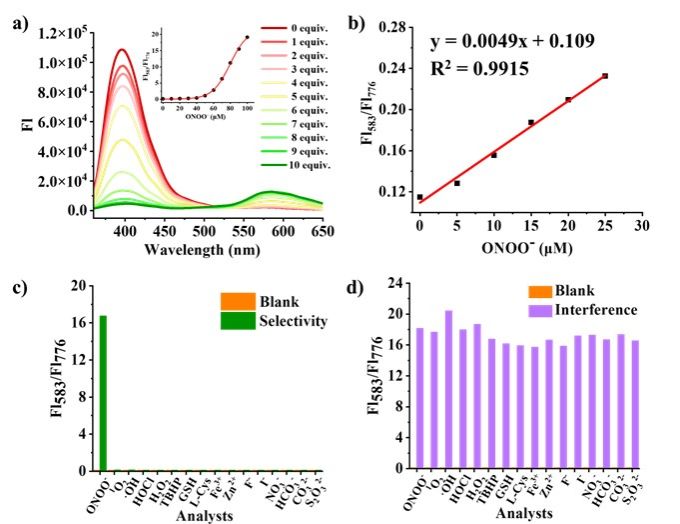
图 2. (a) 添加 ONOO− (0−100 μM) 后 HBT-Fl-BnB 的荧光光谱。插图:FI583/FI396 与 ONOO− (0.0−100 μM) 的比率。 (b) FI583/FI396 比率与 ONOO− 浓度 (0.0−25 μM) 的线性关系。 (c) 添加 ONOO- 或其他干扰分析物以及 (d) 在竞争性分析物存在下添加 ONOO- 后 HBT-F1-BnB 的荧光强度比 (FI583/FI396)。测试条件:10 μM HBT-Fl-BnB、10 mM PBS 缓冲液(含 5% THF、0.2% Tween)、pH = 7.4 和 λex = 340 nm。其他干扰分析物:ONOO− , 1 O2, ·OH, HOCl, H2O2, NO, TBHP, GSH, L-Cys, Sec, Cys-SSH, Fe3+ , Zn2+ , F− , I − , SO4 2− , NO2 , HCO3 、CO3 2− 和 S2O3 2− 。
Figure 2. (a) Fluorescence spectra of HBT-Fl-BnB upon the addition of ONOO− (0‒100 μM), inset: the ratio of FI583/FI396 vs. ONOO− (0.0-100 μM); (b) Linearity for the ratio of FI583/FI396 vs. ONOO− concentrations (0.0-25 μM); Fluorescent intensity ratio (FI583/FI396) of HBT-Fl-BnB upon (c) adding ONOO− or other interfering analytes respectively, and (d) adding ONOO− in the presence of competitive analytes. Test conditions: 10 μM HBT-Fl-BnB, and 10 mM PBS buffer with 5% THF, 0.2% Tween, pH = 7.4, λex = 340 nm). Other interfering analytes: ONOO‒, 1O2, ·OH, HOCl, H2O2, NO, TBHP, GSH, L-Cys, Sec, Cys-SSH, Fe3+, Zn2+, F‒, I‒, SO42‒, NO2‒, HCO3‒, CO32‒ and S2O32‒.
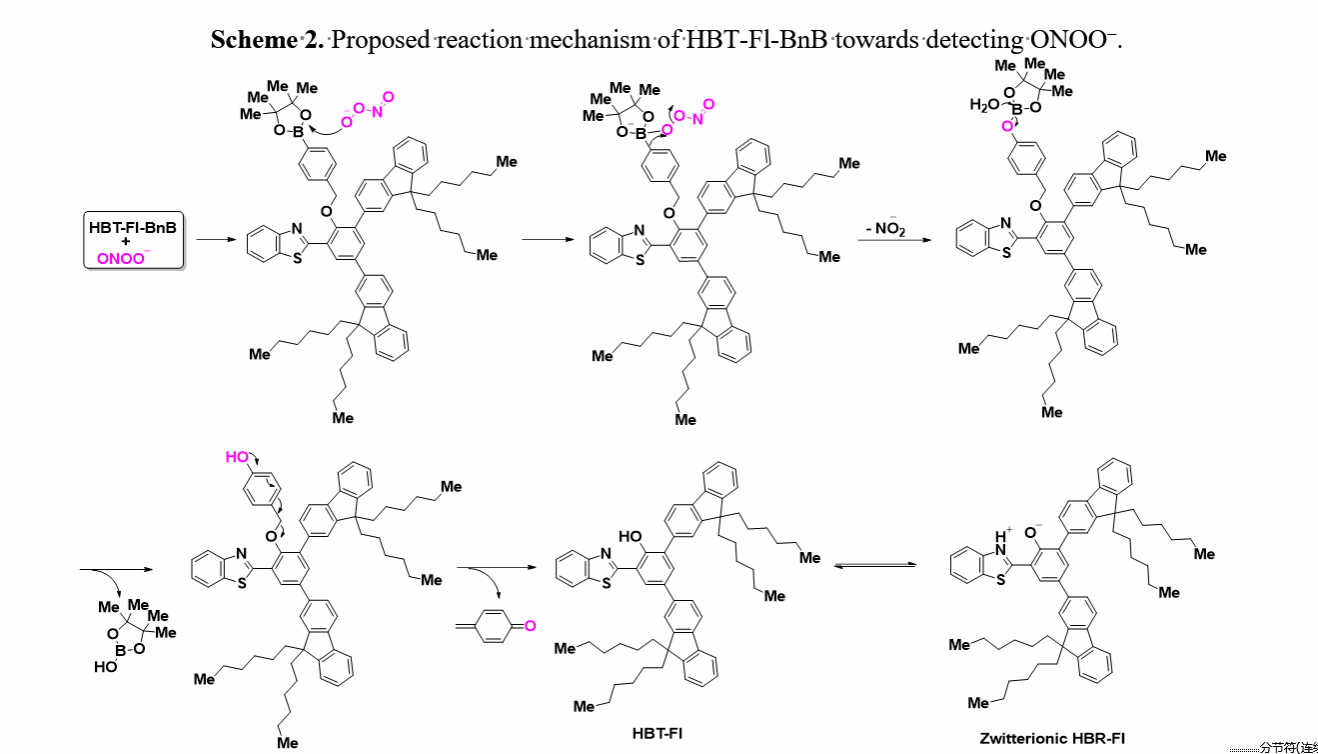
方案2. HBT-Fl-BnB检测ONOO的拟议反应机制。
Scheme 2. Proposed reaction mechanism of HBT-Fl-BnB towards detecting ONOO−.

图 3. Raw264.7 细胞的共焦荧光成像。
Figure 3. Confocal fluorescence imaging of Raw264.7 cells. (a) Control group: cells were only incubated with HBT-Fl-BnB. Cells were stimulated with exogenous ROS/RNS: (b) H2O2; (c) HOCl; (d) NO; (e) O2·−; (f) ONOO− (10 μM in PBS buffer), then with HBT-Fl-BnB. 430ch: λem= 415-515 nm, 583ch: λem=550-650 nm. Ratio images generated from 583ch/430ch. λex=405 nm, scale bar: 20 μm. (g) Normalized average fluorescence intensity of Fl583/Fl430. *** P<0.001. The experiments were repeated three times and the data were shown as mean (±S.D.).
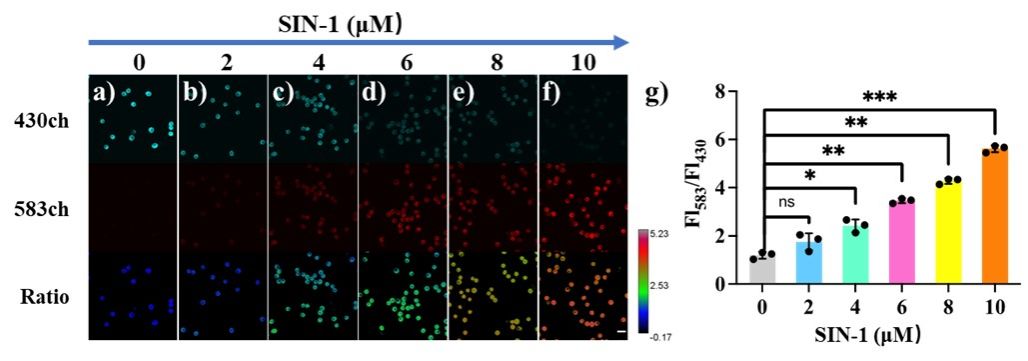
图 4. Raw264.7 细胞的共焦荧光成像。
Figure 4. Confocal fluorescence imaging of Raw264.7 cells. Cells were stimulated with different concentrations of ONOO−, (a) 0; (b) 2); (c) 4); (d) 6; (e) 8 and (f) 10 μM, then with HBT-Fl-BnB. 430ch: λem= 415-515 nm, 583ch: λem=550-650 nm. Ratio images generated from 583ch/430ch. λex=405 nm, scale bar: 20 μm. (g) Normalized average fluorescence intensity of Fl583/Fl430. * P<0.05, ** P<0.01 *** P<0.001. The experiments were repeated three times and the data were shown as mean (±S.D.).
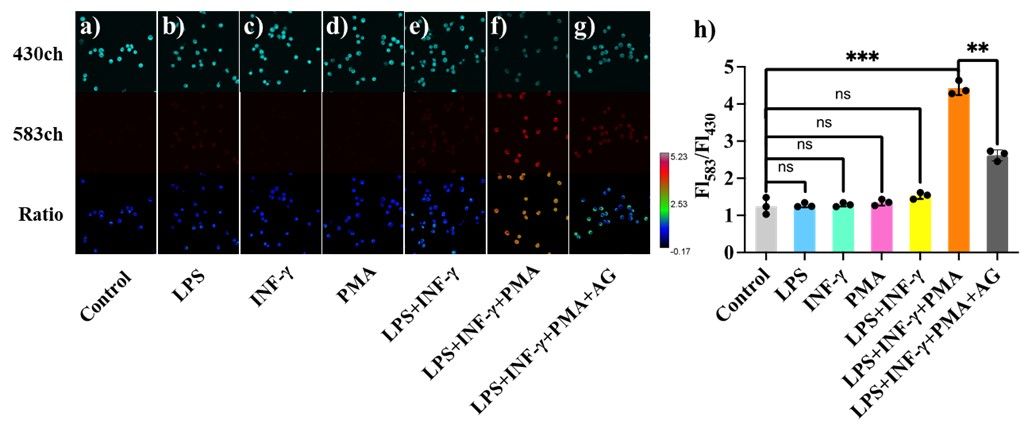
图 5. Raw264.7 细胞的共焦荧光成像。
Figure 5. Confocal fluorescence imaging of Raw264.7 cells. (a) Control group: cells were only incubated with HBT-Fl-BnB. Cells were stimulated with different stimuli: (b) LPS (1 μg/mL); (c) IFN-γ (50 ng/mL); (d) PMA (10 nmol/L); (e) LPS (1 μg/mL) + IFN-γ (50 ng/mL); (f) LPS (1 μg/mL) + IFN-γ (50 ng/mL), then with PMA (10 nmol/L); and (g) AG (1 mmol/L) + LPS ( 1 μg/mL) + IFN-γ (50 ng/mL), then with PMA (10 nmol/L); then were further incubated with HBT-Fl-BnB. 430ch: λem= 415-515 nm, 583ch: λem=550-650 nm. Ratio images generated from 583ch/430ch. λex=405 nm, scale bar: 20 μm. (h) Normalized average fluorescence intensity of Fl583/Fl430. ** P<0.01 *** P<0.001. The experiments were repeated three times and the data were shown as mean (±S.D.).
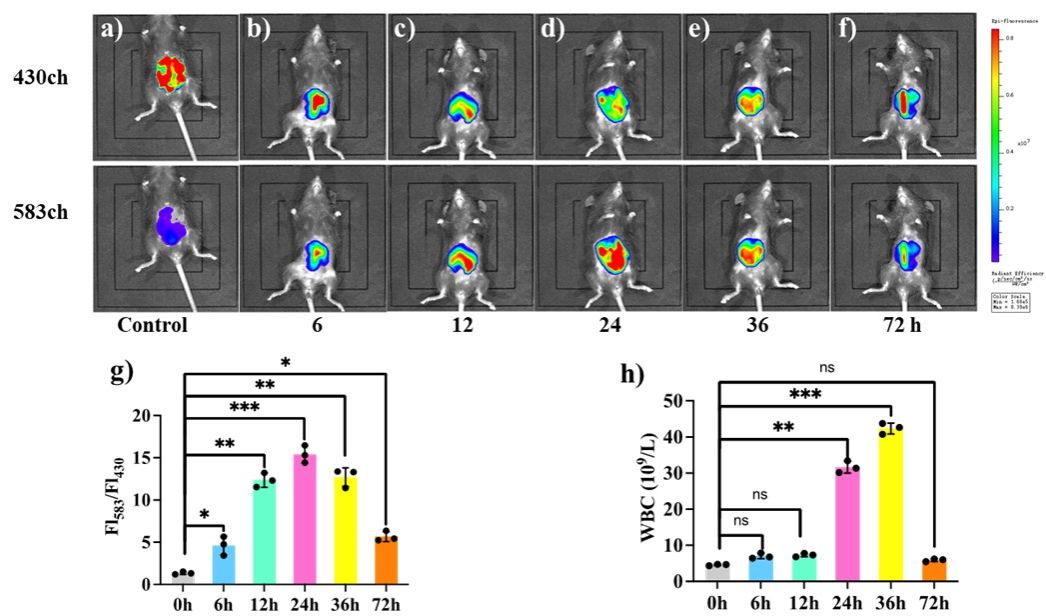
图 6. 在大肠杆菌引起急性腹膜炎期间用小鼠荧光成像监测 ONOO−。
Figure 6. Fluorescence imaging of mice to monitor ONOO− during the Escherichia coli caused acute peritonitis. Mice were intraperitoneally injected with inactivated Escherichia coli (2 × 107 CFU), and after (a) 0, (b) 6, (c)12, (d) 24, (e) 36, (f) 72 h, HBT-Fl-BnB (50 μM, 200 μL) was injected through the tail vein. (g) Normalized average fluorescence intensity of Fl583/Fl430. 430ch: λem= 415-515 nm, 583ch: λem=550-650 nm. λex=405 nm. (h) Changes of WBC during acute peritonitis in mice. * P<0.05, ** P<0.01 *** P<0.001. The experiments were repeated three times and the data were shown as mean (±S.D.).
Conclusion
In summary, a novel ratiometrically fluorescent probe HBT-Fl-BnB featuring a zwitterionic ESIPT was firstly synthesized to detect ONOO− in vitro and in vivo. An HBT core with two Fl groups at the ortho and para positions of OH responding to the zwitterionic ESIPT, and a boronic acid pinacol ester possessing dual roles that blocking the zwitterionic ESIPT as well as sensing ONOO− are both presented in HBT-Fl-BnB. This designed probe enabled a quantitative and ratiometric detection of ONOO− with high selectivity and sensitivity. Considering the low cytotoxicity and high selectivity of HBT-Fl-BnB towards ONOO−, the success in monitoring and imaging of endogenous and exogenous ONOO− in living cells and mice was obtained. Importantly, the abnormal expression of ONOO− in vivo induced by inactivated Escherichia coli was also confirmed by HBT-Fl-BnB, which provided a potential strategy to understand relevant pathogenic mechanism. We envision that this strategy will inspire future probe design with infrared emission.
https://blog.sciencenet.cn/blog-2438823-1423567.html
上一篇:Fluorescence Probe for Pathological Stages of Wound Healing
下一篇:Triphenylamine-AIE Materials for Cancer Theranostics